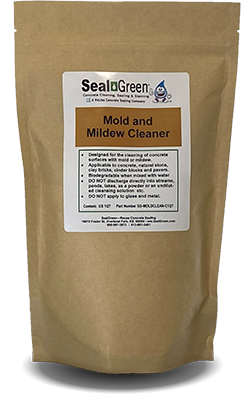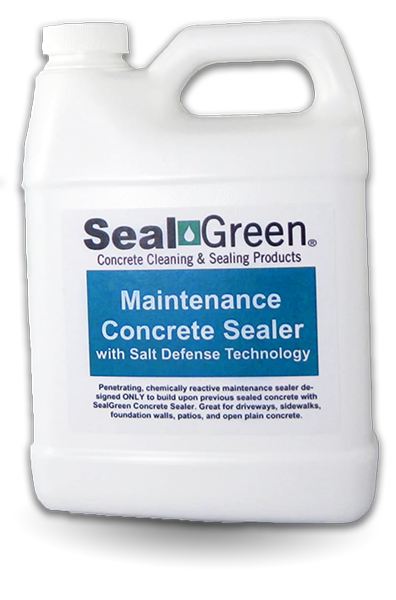Description
The SealGreen E15 Stamped Concrete Sealer is a water-based, one part, ready-to-apply epoxy that is a dream to apply and will last from two to three years depending on weather exposure. It requires two coats of sealer the first time it is applied, and two coats future maintenance, and will go over most other sealers. (We suggest testing the sealer first – see “Testing” below). SealGreen E15 is fast drying so both coats of sealer can be applied on the same day. It is applied by pouring on the patio and rolling it or use paint tray with a puffy roller, we recommend 1 and 1/4 inch nap shed-free roller.
SealGreen products all ship FREE but only by UPS ground shipping. No rush shipping!
1 Gallon covers 600 to 750 sq.ft.
The sealer is applied like painting a wall. Avoid puddling of the sealer as it may turn white for a time if it is too thick. These areas will take longer to cure. The sealer will also take longer to cure if there is a lot of humidity in the air. It is safe to walk on as soon the sealer is dry but it would be best to wait at least 8 to 12 hours before putting furniture on the surface to allow the sealer time to fully cure.
Sealing the stamped concrete makes the concrete surface beautiful but can also create a slippery surface when wet. Anti-skid should be applied to the concrete surface, especially around pool decks, entries, patios, etc. in order to reduce the danger of slipping. Anti-skid is best applied to the surface before the first coat of sealer has been applied. To apply, toss the anti-skid forcefully against the floor to spread it evenly and then apply the two coats of sealer over the anti-skid. Try to avoid putting down too much as this will affect the appearance of the concrete surface but don’t put too little as it will not prevent slipping when the surface is wet.
Stamped and Colored Concrete Maintenance – Key steps to reduce, costly repairs and to keep your stamped, colored concrete looking great.
Testing
It is always best to test the sealer on your stamped concrete before you proceed with cleaning, staining and sealing. Many people with stamped, colored concrete call us to say that their concrete needs to be stained and then sealed. As acrylic sealers breakdown, they create a dull residue on the surface. Testing with SealGreen E15 Test Kit can effectively tell you if you need to re-stain or if the concrete simply needs to be stained and sealed. The E15 Test Kit comes with a 4 ounce bottle of ready-to-use cleaner, a 4 ounce bottle of E15 Stamped Concrete Sealer and Test instructions
To test, you must use the cleaner and clean a small area of your stamped concrete in an inconspicuous location, allow it to thoroughly dry, and then apply the E15. If the result is a return of the color and the gloss that you want to see on your surface with no wrinkling or other adverse effects, the SealGreen 3 Step Solution will work wonders on your stamped concrete.
Maintaining Stamped Concrete
Maintaining stamped decorative concrete has long been the homeowner’s and installer’s worst nightmare. Many installers simply refuse to do the maintenance on stamped concrete citing that there isn’t enough money in it for them to do it or that it takes too long. And homeowner’s are lost in a bewildering array of sealers all shouting from the rooftops that “I am the best sealer!” while all of them are basically acrylic chemistry with the same inherent problems
- requires a dry, clean surface for best application
- manufacturer recommended TWO thin coats 12 hours apart
- rigid temperature and humidity ranges when the sealer can be applied without creating problems
- the short life of the sealer. Bubbles, hazing, milkiness and peeling are just a few of the problems faced when these rigid requirements are not met.
SealGreen-ReUse Concrete Sealing has formulated a NEW approach to the problem of maintaining stamped concrete – a one-part, water-based, ready-to-use epoxy sealer – SealGreen E15 Stamped Concrete Sealer. It is easy to use, has no VOC’s, is environmentally-friendly, dries quickly and lasts twice as long as the standard acrylic sealers with none of the bubbling or hazing problems because the epoxy breathes, allowing air to pass through while inhibiting water passage.
SealGreen’s three-step solution to maintaining stamped decorative concrete eliminates these problems. Not only will stamped concrete look beautiful but it will require less maintenance – every three to five years as opposed to every year. And the cleaners and sealers used are all environmentally-friendly, low VOC’s, and easy to use. (link to application procedures)
Traditional Procedures and Their Problems for Maintaining Stamped Concrete
Stamped Concrete is decorative concrete to which color and a pattern has been stamped into it. It can be found on patios, entries, driveways, screened-in porches, pool decks, etc. It adds beauty to a home while serving as a functional part of the home. Many people with stamped decorative concrete do not know that this type of concrete typically needs annual maintenance in order to retain its beauty.
The traditional sealers used on stamped decorative concrete are acrylic sealers. These sealers come under many names and brands but the basic chemistry is acrylic-based.
Acrylic sealers bring the color alive. They provide a glossy surface that is resistant to staining which gives the concrete the “wet look” that many people desire. Alas, acrylic sealers come with inherent problems that can make them difficult and costly to use. They have a short life usually lasting anywhere between 6 months and 18 months depending on the percentage of solids (acrylics) in the sealer. Acrylic sealers break down in extreme temperatures – either hot or cold. They are apt to bubble if the concrete is too hot when they are applied. Moisture encapsulated under the sealer can cause white areas. This can cause blistering, peeling, chipping, and other problems. Many installers hate resealing stamped concrete because of the many problems with acrylic sealers.
The typical answer to any of the problems listed above is to put another coat of sealer on top of the ones already there or to use zylene over the sealer. Zylene thins and reactives the acrylic allowing it to be rolled again to help get rid of white areas and/or bubbles. The problems inherent in these answers is that over time, recoating the concrete builds up layers of sealer that at some point will need to be removed to restore the surface to its former glory. And zylene, although an effective solution at the time, actually thins the sealer which dramatically reduces the sealer’s life. For more information on stamped concrete, please download our White Paper – 5 Things to Know about Maintaining Stamped Concrete (link to download) or read it here (link to library).
SealGreen Three Step Solution to Stamped Concrete Maintenance:
- Wash Stamped Concrete
- Let Dry
- Apply Two Coats of SealGreen E15 Stamped Concrete Epoxy Sealer




